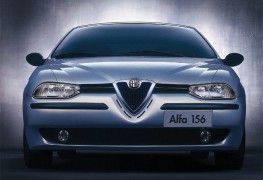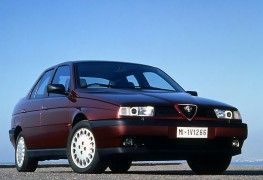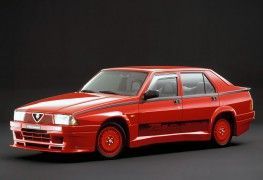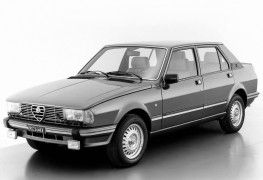But soon all that came to nothing. The platform has little or nothing to do with the one used by Maserati in its models, being a practically new work created from scratch. And the engine... Well, the engine is another story entirely.
Maserati's Ghibli uses a three-litre twin-turbo petrol V6 with direct injection, which led one to believe that it was the same engine, or at least the "father" of the Alfa Romeo engine. But the Maserati's engine has 60-degree camshafts. The new Giulia, on the other hand, uses an engine with the banks separated by 90 degrees.
To make matters more complicated, there are also the bore to stroke ratios. Maserati uses pistons with a bore of 86.5 millimetres and 84.5 millimetres of stroke, while the Alfa Romeo's pistons have the same bore but a shorter stroke of 82 millimetres. This creates cylinders with a unit displacement of 481.875 cubic centimeters, giving the Giulia's engine a displacement of 2.89 liters (even if it rounds up to the advertised three liters).
But is this an all-new engine design then? Well, no. And that's where Ferrari comes into this whole thing. Chatting to various people in the company connected with the project, one of them explained to me that "the engine is three-quarters Ferrari", while another invited me to "do some more research into it".
Well, that's what we've been doing these days, until we found the key: it turns out that when Ferrari had to take on the development of its new turbocharged V8 engines, it did so with scalable modular engines in mind. Thus, the 481.875 cubic centimeter unitary cylinder was created, and around it they worked to develop all the possible mechanics.
This is how the engine of the California T was born, and this is where it gets interesting. Do you know what the engine dimensions of the Ferrari convertible are? Exactly the same as the Giulia's: 86.5 x 82.
The Giulia's block is a direct twin of the one used in the California T, except that the two front cylinders have been removed. Another important change comes from the crankshaft draft: like any good Ferrari V8, the California T has a "flat crankshaft", but that can't be applied "as is" to a V6 at ninety degrees.
If you remember, Alfa Romeo's mythical V6, the Busso, had its banks at 60 degrees, and that's the perfect configuration for a V6 if you want to eliminate first and second order vibrations in a "natural" way. That's one of the reasons Maserati uses that angle as well. Using a more open V-twin allows the Giulia to lower the center of gravity and share elements with Ferrari much more intensively, but it required playing with the firing order and crankshaft crankpin draft.
Again we went to our sources in the brand to clarify the crankshaft draft, but there are no images or information available "in the open" about it, so we had to manage to analyze the images of the presentation of the car in Frankfurt, where you could see an animation of the engine running (pity a version of the image at higher resolution, right?).
Normally, what is usually done with V6 engines with 90-degree banks is to make the two central cylinders do not share crankpin, moving thirty degrees of a cylinder with respect to the other, to achieve a detonation every 120 degrees of crankshaft rotation. But in the Giulia, as you can see below, this has not been done, as this would have implied lengthening the crankshaft and modifying the distance between the centers of the cylinders in the block.
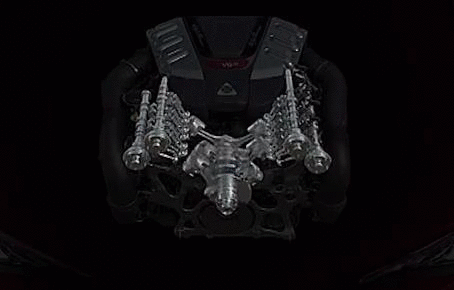
Playing with counterweights and a more than likely, but not visible, balancer shaft, the Giulia's V6 thus maintains a crankshaft design very similar to that used by Ferrari in its V8s, and also characterizes its exhaust sound, which is completely different from that of other V6s on the market.
Another minor change compared to the California T is the compression ratio. The Ferrari's combustion chamber specification uses 9.4:1, while the Giulia's is 9.3:1, practically the same, but slightly lower. The variable valve timing and direct injection system are also "brothers" between the Ferrari and the Alfa.
The cylinder head is modified, in any case, to add the selective cylinder deactivation system on the left bank, in order to reduce consumption, something that for the moment does not have the Ferrari (but it seems that it will arrive sooner rather than later).
Another aspect where there has been a great technological transfer is in the supercharger system. Ferrari invested heavily in the development of a twin inlet turbocharger system, one for each bank, and all that technology has been adapted to the Alfa engine, to obtain, promises the firm, an instant throttle response, as if there were no turbocharger in between. We'll have to try it out.
Finally, another great point to comment on is the subject of gearboxes. We talked at length at the time about the need for FCA to create new gearboxes for rear-wheel drive cars in order to tackle the Alfa Romeo project. By using a "Ferrari" block, the new Alfa Romeo also shares the clutch bell with the Maranello firm. And this is no coincidence.
While the Giulia has already been shown to us with a six-speed manual gearbox, it will also be marketed with a dual-clutch automatic. There had been much speculation about the option of the same eight-speed ZF automatic from the Ghibli, but according to our findings, the Giulia will get the same seven-speed dual-clutch gearbox used in the aforementioned California T, made by Gtrag. The integration of the active rear differential is another derivation of the active self-locking differential already launched on products like the 458 Speciale.
All in all, what conclusion should we draw from all this? The truth is that words are nice, but in the end what matters about a machine like this is how it drives. But the ingredients, we can now prove it, are "Ferrari", but "real Ferrari". Besides, I'm sure that the idea of having "three quarters of a Ferrari engine plus gearbox" in your saloon is sure to thrill more than one tifosi.
The return of Alfa Romeo: from the 1900 to the Giulia
